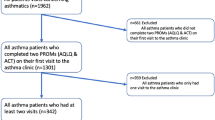Abstract
Objectives: To establish a link between the minimal important difference (MID) and the standard error of measurement (SEM) for all responsive dimensions of the Asthma Quality of Life Questionnaire (AQLQ). Methods: Secondary data analysis of baseline and follow-up interview data from 198 outpatients with asthma enrolled in a randomized controlled trial and receiving care at a major urban academic medical center's general medicine clinics. Domain statistics for baseline and follow-up interviews were examined for the AQLQ. The baseline SEM values were compared with established AQLQ MID standards using weighted κ values. Results: One SEM identified the MID in responsive AQLQ dimensions. Weighted κ values (0.88–0.93) validated excellent agreement between these two criteria. Conclusion: This is the third study to support using one SEM to identify important individual change in health-related quality of life (HRQoL) measures. However, refinement of the process for determining a measure's clinically meaningful differences is still needed to secure a link between the SEM and the identification of relevant HRQoL change over time.
Similar content being viewed by others
References
Jaeschke R, Singer J, Guyatt G. Measurement of health status: Ascertaining the minimal clinically important difference. Controlled Clin Trials 1989; 10: 407–415.
Juniper EF, Guyatt GH, Willan A, Griffith LE. Determining a minimal important change in a disease-specific quality of life questionnaire. J Clin Epidemiol 1994; 47: 81–87.
Juniper EF, Guyatt GH, Feeny PJ, Griffith LE, Townsend M. Measuring quality of life in children with asthma. Qual Life Res 1996; 5: 35–46.
Guyatt GH, Nogradi S, Halcrow S, Singer J, Sullivan MJ, Fallen EL. Development and testing of a new measure of health status for clinical trials in heart failure. J Gen Int Med 1989; 4: 101–107.
Guyatt GH, Berman LB, Townsend M, Pugsley SO, Chambers LW. A measure of quality of life for clinical trials in chronic lung disease. Thorax 1987; 42: 773–778.
Juniper EF, Guyatt GH, Feeny PJ, Griffith LE. Measuring quality of life in asthma. Am Rev Respir Dis 1993; 127: 832–838.
Wyrwich KW, Tierney WM, Wolinsky FD. Further evidence supporting a SEM-based criterion for identifying meaningful intra-individual changes in health-related quality of life. J Clin Epidemiol 1999; 52(9): 861–873.
Wolinsky FD, Wyrwich KW, Nienaber NA, Tierney WM. Generic vs. disease-specific health status measures: An example using coronary artery disease and/or congestive heart failure patients. Eval Health Professions 1998; 21: 216–243.
Wyrwich KW, Nienaber NA, Tierney WM, Wolinsky FD. Linking clinical relevance and statistical significance in evaluating intra-individual changes in health-related quality of life. Med Care 1999; 37(4): 469–478.
Nunnally JC, Bernstein IH. Psychometric Theory. New York: McGraw Hill, 1994.
Tierney WM, Miller ME, Hui SL, McDonald CJ. Practice randomization and clinical research. The Indiana experience. Med Care 1991; 29: JS57-JS64.
McDonald CJ, Overhage JM, Tierney WM, et al. The Regenstrief Medical Record System: A quarter century experience. Int J Med Informatics 1999; 54(3): 225–253.
Anie KA, Jones PW, Hilton SR, Anderson HR. A computer-assisted telephone interview technique for assessment of asthma morbidity and drug use in adult asthma. J Clin Epidemiol 1996; 49(6): 653–656.
Guyatt GH, Juniper EF, Walter SD, Griffith LE, Goldstein RS. Interpreting treatment effects in randomised trials. Br Med J 1998; 316(7132): 690–693.
Juniper EF, Johnston Pr, Borkhoff CM, Guyatt GH, Boulet LP, Haukioja. Quality of life in asthma clinical trials: Comparison of salmeterol and salbutamol. Am J Respir Care Med 1995; 151(1): 66–70.
Turner MO, Taylor D, Bennett R, Fitzgerald JM. A randomized trial comparing peak expiratory flow and symptom self-management plans for patients with asthma attending a primary care clinic. Am J Respir Critical Care Med 1998; 157: 540–546.
Wenzel SE, Lumry W, Mamming M, et al. Efficacy, safety, and effects on quality of life of salmeterol versus albuterol in patients with mild to moderate persistent asthma. Ann Allergy, Asthma Immunol 1998; 80: 463–470.
Quality of Life Resources: Measurement Properties. [Online]. American Thoracic Society. <http://www.atsqol.org/ keyframe.html/> (2000, Sept. 1).
Statistical Package for the Social Sciences. SPSS for windows, release 10.0.5. Chicago: SPSS, Inc. 1999.
McHorney CA, Tarlov AR. Individual-patient monitoring in clinical practice: Are available health status surveys adequate? Qual Life Res 1995; 4: 293–307.
Ware Jr, Kemp JP, Buchner DA, Singer AE, Nolop KB, Goss TF. The responsiveness of disease-specific and generic health measures to changes in the severity of asthma among adults. Qual Life Res 1998; 7: 235–244.
Cohen J. Statistical Power Analysis for the Behavioral Sciences. New York: Academic Press, 1977.
Norman GR, Stratford P, Regehr G. Methodological problems in the retrospective computation of responsiveness to change: The lessons of Cronbach. J Clin Epidemiol 1997; 50(8): 869–879.
Naylor CD, Llewellyn-Thomas HA. Can there be a more patient-centred approach to determining clinically important effect sizes for randomized trial? J Clin Epidemiol 1994; 47(7): 787–795.
Stephens R, Hopwood P, Girling D, Machin D. Randomized trials with quality of life endpoints: are doctors' rating of patients' physical symptoms interchangeable with patients' self-ratings? Qual Life Res 1997; 6: 225–236.
Author information
Authors and Affiliations
Corresponding author
Rights and permissions
About this article
Cite this article
Wyrwich, K.W., Tierney, W.M. & Wolinsky, F.D. Using the standard error of measurement to identify important changes on the Asthma Quality of Life Questionnaire. Qual Life Res 11, 1–7 (2002). https://doi.org/10.1023/A:1014485627744
Issue Date:
DOI: https://doi.org/10.1023/A:1014485627744




